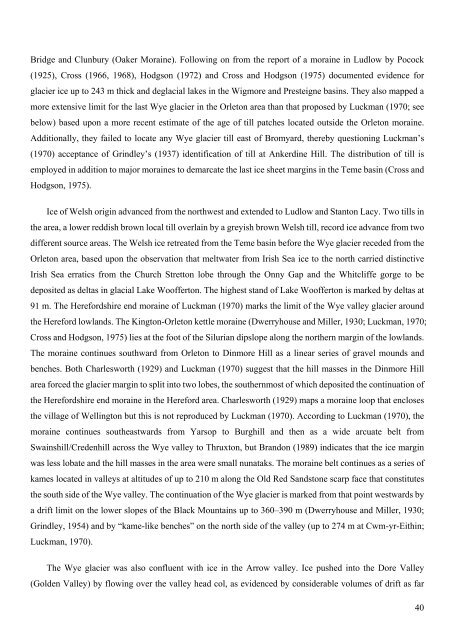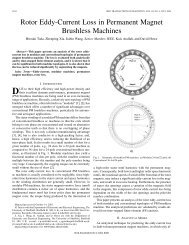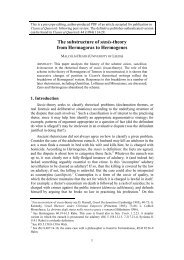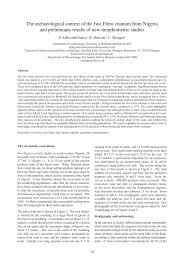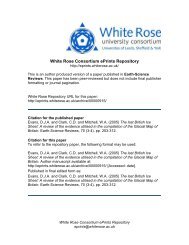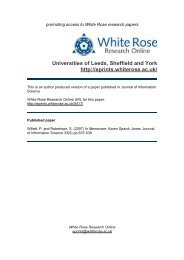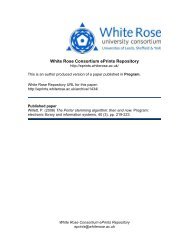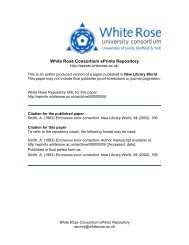The last British Ice Sheet: A review of the evidence utilised in the ...
The last British Ice Sheet: A review of the evidence utilised in the ...
The last British Ice Sheet: A review of the evidence utilised in the ...
You also want an ePaper? Increase the reach of your titles
YUMPU automatically turns print PDFs into web optimized ePapers that Google loves.
Bridge and Clunbury (Oaker Mora<strong>in</strong>e). Follow<strong>in</strong>g on from <strong>the</strong> report <strong>of</strong> a mora<strong>in</strong>e <strong>in</strong> Ludlow by Pocock<br />
(1925), Cross (1966, 1968), Hodgson (1972) and Cross and Hodgson (1975) documented <strong>evidence</strong> for<br />
glacier ice up to 243 m thick and deglacial lakes <strong>in</strong> <strong>the</strong> Wigmore and Presteigne bas<strong>in</strong>s. <strong>The</strong>y also mapped a<br />
more extensive limit for <strong>the</strong> <strong>last</strong> Wye glacier <strong>in</strong> <strong>the</strong> Orleton area than that proposed by Luckman (1970; see<br />
below) based upon a more recent estimate <strong>of</strong> <strong>the</strong> age <strong>of</strong> till patches located outside <strong>the</strong> Orleton mora<strong>in</strong>e.<br />
Additionally, <strong>the</strong>y failed to locate any Wye glacier till east <strong>of</strong> Bromyard, <strong>the</strong>reby question<strong>in</strong>g Luckman’s<br />
(1970) acceptance <strong>of</strong> Gr<strong>in</strong>dley’s (1937) identification <strong>of</strong> till at Ankerd<strong>in</strong>e Hill. <strong>The</strong> distribution <strong>of</strong> till is<br />
employed <strong>in</strong> addition to major mora<strong>in</strong>es to demarcate <strong>the</strong> <strong>last</strong> ice sheet marg<strong>in</strong>s <strong>in</strong> <strong>the</strong> Teme bas<strong>in</strong> (Cross and<br />
Hodgson, 1975).<br />
<strong>Ice</strong> <strong>of</strong> Welsh orig<strong>in</strong> advanced from <strong>the</strong> northwest and extended to Ludlow and Stanton Lacy. Two tills <strong>in</strong><br />
<strong>the</strong> area, a lower reddish brown local till overla<strong>in</strong> by a greyish brown Welsh till, record ice advance from two<br />
different source areas. <strong>The</strong> Welsh ice retreated from <strong>the</strong> Teme bas<strong>in</strong> before <strong>the</strong> Wye glacier receded from <strong>the</strong><br />
Orleton area, based upon <strong>the</strong> observation that meltwater from Irish Sea ice to <strong>the</strong> north carried dist<strong>in</strong>ctive<br />
Irish Sea erratics from <strong>the</strong> Church Stretton lobe through <strong>the</strong> Onny Gap and <strong>the</strong> Whitcliffe gorge to be<br />
deposited as deltas <strong>in</strong> glacial Lake Wo<strong>of</strong>ferton. <strong>The</strong> highest stand <strong>of</strong> Lake Wo<strong>of</strong>ferton is marked by deltas at<br />
91 m. <strong>The</strong> Herefordshire end mora<strong>in</strong>e <strong>of</strong> Luckman (1970) marks <strong>the</strong> limit <strong>of</strong> <strong>the</strong> Wye valley glacier around<br />
<strong>the</strong> Hereford lowlands. <strong>The</strong> K<strong>in</strong>gton-Orleton kettle mora<strong>in</strong>e (Dwerryhouse and Miller, 1930; Luckman, 1970;<br />
Cross and Hodgson, 1975) lies at <strong>the</strong> foot <strong>of</strong> <strong>the</strong> Silurian dipslope along <strong>the</strong> nor<strong>the</strong>rn marg<strong>in</strong> <strong>of</strong> <strong>the</strong> lowlands.<br />
<strong>The</strong> mora<strong>in</strong>e cont<strong>in</strong>ues southward from Orleton to D<strong>in</strong>more Hill as a l<strong>in</strong>ear series <strong>of</strong> gravel mounds and<br />
benches. Both Charlesworth (1929) and Luckman (1970) suggest that <strong>the</strong> hill masses <strong>in</strong> <strong>the</strong> D<strong>in</strong>more Hill<br />
area forced <strong>the</strong> glacier marg<strong>in</strong> to split <strong>in</strong>to two lobes, <strong>the</strong> sou<strong>the</strong>rnmost <strong>of</strong> which deposited <strong>the</strong> cont<strong>in</strong>uation <strong>of</strong><br />
<strong>the</strong> Herefordshire end mora<strong>in</strong>e <strong>in</strong> <strong>the</strong> Hereford area. Charlesworth (1929) maps a mora<strong>in</strong>e loop that encloses<br />
<strong>the</strong> village <strong>of</strong> Well<strong>in</strong>gton but this is not reproduced by Luckman (1970). Accord<strong>in</strong>g to Luckman (1970), <strong>the</strong><br />
mora<strong>in</strong>e cont<strong>in</strong>ues sou<strong>the</strong>astwards from Yarsop to Burghill and <strong>the</strong>n as a wide arcuate belt from<br />
Swa<strong>in</strong>shill/Credenhill across <strong>the</strong> Wye valley to Thruxton, but Brandon (1989) <strong>in</strong>dicates that <strong>the</strong> ice marg<strong>in</strong><br />
was less lobate and <strong>the</strong> hill masses <strong>in</strong> <strong>the</strong> area were small nunataks. <strong>The</strong> mora<strong>in</strong>e belt cont<strong>in</strong>ues as a series <strong>of</strong><br />
kames located <strong>in</strong> valleys at altitudes <strong>of</strong> up to 210 m along <strong>the</strong> Old Red Sandstone scarp face that constitutes<br />
<strong>the</strong> south side <strong>of</strong> <strong>the</strong> Wye valley. <strong>The</strong> cont<strong>in</strong>uation <strong>of</strong> <strong>the</strong> Wye glacier is marked from that po<strong>in</strong>t westwards by<br />
a drift limit on <strong>the</strong> lower slopes <strong>of</strong> <strong>the</strong> Black Mounta<strong>in</strong>s up to 360–390 m (Dwerryhouse and Miller, 1930;<br />
Gr<strong>in</strong>dley, 1954) and by “kame-like benches” on <strong>the</strong> north side <strong>of</strong> <strong>the</strong> valley (up to 274 m at Cwm-yr-Eith<strong>in</strong>;<br />
Luckman, 1970).<br />
<strong>The</strong> Wye glacier was also confluent with ice <strong>in</strong> <strong>the</strong> Arrow valley. <strong>Ice</strong> pushed <strong>in</strong>to <strong>the</strong> Dore Valley<br />
(Golden Valley) by flow<strong>in</strong>g over <strong>the</strong> valley head col, as <strong>evidence</strong>d by considerable volumes <strong>of</strong> drift as far<br />
40


